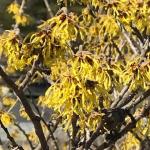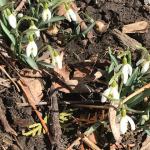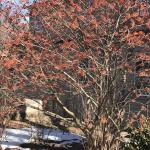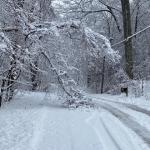UMass Extension's Landscape Message is an educational newsletter intended to inform and guide Massachusetts Green Industry professionals in the management of our collective landscape. Detailed reports from scouts and Extension specialists on growing conditions, pest activity, and cultural practices for the management of woody ornamentals, trees, and turf are regular features. The following issue has been updated to provide timely management information and the latest regional news and environmental data.
This is the first issue of the Landscape Message for 2023... thanks for your continuing interest! To receive immediate notification when the next Landscape Message update is posted, be sure to join our e-mail list
To read individual sections of the message, click on the section headings below to expand the content:
Scouting Information by Region
Environmental Data
The following data was collected on or about March 22, 2023. Total accumulated growing degree days (GDD) represent the heating units above a 50º F baseline temperature collected via regional NEWA stations (http://newa.cornell.edu) for the 2023 calendar year. This information is intended for use as a guide for monitoring the developmental stages of pests in your location and planning management strategies accordingly.
|
MA Region/Location |
GDD |
Soil Temp |
Precipitation |
Time/Date of Readings |
||||||
|
2022 Total |
Current 2023 |
Sun |
Shade |
(Since 1/1) / (Since 3/1) | ||||||
|
CAPE |
2994 |
9 |
45 |
40 |
14.79 / 2.9 |
12:00 PM 3/22 |
||||
|
SOUTHEAST |
3062 |
13 | 49 | 42 | 19.91 / 2.53 | 3:00 PM 3/22 | ||||
|
NORTH SHORE |
2915 |
4 | 42 |
39 |
10.91 / 3.88 | 10:00 AM 3/22 | ||||
|
EAST |
3226 |
13 | 48 | 41 | 9.43 / 3.63 | 4:00 PM 3/22 | ||||
|
METRO |
2959 |
5 | 39 | 38 | 8.87 / 3.77 | 6:30 AM 3/23 | ||||
|
CENTRAL |
3016 |
3 | 37 | 39 | 9.33 / 5.2 | 7:30 AM 3/22 | ||||
|
PIONEER VALLEY |
2970.5 |
1 | 42 | 40 | 11.46 / 3.66 | 1:00 PM 3/22 | ||||
|
BERKSHIRES |
2391 |
0 | 33 | 34 | 8.71 / 2.82 | 9:00 AM 3/22 | ||||
|
AVERAGE |
2942 |
6 | 42 | 39 | 11.68 / 3.55 | |||||
|
* = information not available |
||||||||||
Phenology
| Indicator Plants - Stages of Flowering (BEGIN, BEGIN/FULL, FULL, FULL/END, END) | ||||||||
|---|---|---|---|---|---|---|---|---|
| PLANT NAME (Botanic / Common) | CAPE | S.E. | N.S. | EAST | METRO W. | CENT. | P.V. | BERK. |
|
Hamamelis x intermedia (witch hazel hybrids) |
Full/End |
* |
Full/End |
Full/End |
Full/End |
Full/End |
Full/End |
Full |
|
Hamamelis mollis (Chinese witch hazel) |
Full/End |
Full/End |
Full/End |
Full/End |
Full/End |
Full/End |
Full/End |
Full |
|
Acer saccharinum (silver maple) |
Begin/Full |
Full |
Full |
Begin/Full |
Begin/Full |
Full |
Full |
Begin |
| * = no activity to report/information not available | ||||||||
Regional Notes
Cape Cod Region (Barnstable)
General Conditions: The average temperature for March has been 39°F, with a high of 58°F on March 21 and a low of 27°F on March 20. March highs have been in the 40s and lows in 30s with only a couple days warmer than 50°F or cooler than 30°F. The month of March has had more cloudy days than sunny days. Precipitation occurred in several events with a total of 2.90 inches so far this month.
Overall the winter has been mild with only a few temperature extremes which primarily took place in February with a high of near 70°F on Feb. 16 and a low of -8°F on February 4. The ground froze briefly to a depth of 3-4 inches in early February but otherwise was mainly unfrozen. Precipitation during the winter was almost entirely rain, with very few snowfall events and none that were significant. A lot of precipitation occurred in January with the rain gauge in Barnstable measuring more than 9”. Fittingly, the number of sunny days in January could be counted on a single hand.
Plants seen in bloom include crocus, snowdrops (Galanthus nivalis), lenten rose (Helleborus spp.) and hyacinth (Hyacinthus orientalis).
Pests/Problems: Winter injury has been significant this winter even with the mild conditions. Winter bronzing could be seen on many needled evergreens including junipers (Juniperus spp.), Leyland cypress (Cupressus x leylandii), arborvitae (Thuja spp.), and Siberian cypress (Microbiota decussata). Winter injury to boxwood (Buxus spp.) was also observed. The extreme low temperature of Feb. 4 is likely to have caused damage to some plants, especially those that are marginally hardy. Bloom on bigleaf hydrangea (H.macrophylla) will be impacted by that extreme low temperature event. Other plants like butterfly bush (Buddleia davidii) may also be impacted with above ground parts killed.
Insects observed recently include hemlock woolly adelgid on hemlock (Tsuga canadensis), spruce spidermite damage on dwarf Alberta spruce (Picea glauca‘Conica’) and winter cutworms generally. Diseases include pink snow mold or red thread on lawns, black knot on black cherry (Prunus serotina) and White pine needle disease on white pine (Pinus strobus).
Weeds including bittercress (Cardamine hirsuta) and mouse-ear cress (Arabidopsis thaliana) are in bloom. Invasive bush honeysuckles (Lonicera spp.) are starting to show some green buds and the star of Bethlehem flower (Ornithogalum umbellatum) can be seen emerging in dormant lawns.
Southeast Region (Dighton)
General Conditions: We welcomed the Spring equinox on March 20th after an unusually mild Winter. The ground was never quite frozen to any significant depth and there was little snow accumulation. Precipitation was generous since our last report, mercifully ending the severe drought. November 2022 was blustery; with winds gusting as high as 48 mph on the 11th. We had 2.08 inches of precipitation for the month. Temperatures averaged 48°F, with a low of 22°F on the morning of the 22nd. December temperatures were equally moderate, averaging 38°F. The low for the month was 11°F on Christmas morning. Precipitation totaled 5.68 inches. In January 2023 temperatures averaged 39°F. The low was 23°F on the morning of the 26th. Precipitation was quite generous, gaining 8.88 inches overall. February brought a short snap of alarmingly cold temperatures recorded at -7°F on the 2nd. Despite that, temperatures averaged 34°F for the month. The colder air was also drier with a meager accumulation of only 0.74 inches of rain. The short, cold, blast was ushered in by winds gusting to 46 mph, also on the 2nd. March turned warmer, averaging 40°F so far. The coldest morning was 27°F on the 8th. We've had 2.53 inches of precipitation. These weather readings were recorded at New Bedford Regional Airport taken from archives at www.wunderground.com.
Plants currently observed to be flowering include; Acer rubrum (swamp red maple), A. saccharinum (silver maple), Cardamine hirsuta (hairy bittercress), Chionodoxa (glory-of-the-snow), Eranthis hyemalis (winter aconite), Galanthus (snowdrop), Hamamelis mollis (Chinese witch hazel), Narcissus (daffodil), Salix discolor (American pussy willow), S. gracilistyla 'Melanostachys' (black pussy willow), Scilla siberica (Siberian squill), Ulmus americana (American elm). Spring peepers are active.
Pests/Problems: Garlic mustard seed has germinated.
There is quite a bit of bagworm hanging on red cedar and arborvitae. The eggs will not have hatched but now might be a good time to inspect your plants. Bagworm are defoliating and killing these evergreens
North Shore (Beverly)
General Conditions: The year started off mild with average temperatures in the mid-30s to low-40s. Winter temperatures have been variable with some days above average and some days below average.The average daily temperature in January was 35˚F with a maximum temperature of 58˚F and a minimum temperature of 19˚F. February averaged 32˚F with a high of 60˚F and a low of -12˚F. An arctic blast came down at the beginning of February bringing two days of freezing temperatures. March has averaged 37˚F with a high of 57˚F and a low of 25˚F. Winter snowfall was mild at Long Hill and less than average for the region. Signs of spring are evident with some plants starting to bloom. Early spring flowering bulbs seen in bloom include winter aconite (Eranthis hyemalis), ‘Tommie' Crocus (Crocus tommasinianus) and snowdrops (Galanthus nivalis). Blooming trees include: ‘Arnold Promise' witch hazel (Hamamelis x intermedia), Chinese witch hazel (Hamamelis mollis), pussy willow (Salix caprea) and silver maple (Acer saccharinum). Some homeowners and landscapers are already starting to do spring cleanups as weather permits.
Pests/Problems: The population of rabbits seems to be increasing in some areas in the region and damage has been observed on some plants. Winter burn has been seen on azalea, boxwood, cedar and others; especially on unprotected sites facing south/southwest. Evergreen plants exposed to winter sun and winds are desiccated on sunny winter days. Green leaves and needles rapidly lose water through transpiration and are unable to refill their tissues from water in frozen soil, also causing winter burn on leaves.
East Region (Boston)
General Conditions: The 2022 growing season extended into mid-December with a killing frost on December 11. January was mild, daytime temperatures averaged 43°F with a high of 58°F on the 13th. Overnight temperatures averaged 32°F with a low of 21°F on the 11th. We had no temperatures in the teens or a daytime temp below 32°F. Precipitation fell on twenty-one of the thirty-one days in January. The first measurable snow fell on the 15th and 16th totaling 3.1 inches. We received a total of 4.65 inches of rain equivalent for the month. February was mild with one extreme cold event. Daytime temperatures averaged 43°F including four days reaching 60°F. Overnight temperatures averaged 26°F. The cold snap occurred on the 4th and 5th; overnight temperatures dropped to -7.8°F and -11.6°F with a daytime high of 15°F on the 4th. The first measurable snow in February was a winter mix on the 23rd. Total precipitation for February was 1.15 inches. March daytime temperatures have averaged 46°F with a high of 21st, the first full day of spring. Overnight lows have averaged 32°F with a low of 26°F on the 20th. We had a rain, snow, rain event on March 14 delivering 2.19 inches of rain equivalent. Hamamelis vernalis was in full bloom in late January. In mid-February Eranthis hyemalis (winter aconite) and Galanthus nivalis (snow drops) began coming into bloom. The showy and fragrant Viburnum X bodnantense ‘pink dawn' was in full bloom February 13th. Hamamelis x intermedia ‘Arnold promise' began flowering in late February. Symplocarpus foetidus (skunk cabbage) leaves are emerging from wetlands. Red winged blackbirds have returned.
Pests/Problems: We had a lack of snow cover in the landscape the entire winter. Rodent damage is apparent at ground level. Rabbit and deer browse is visible on susceptible border plants. Signs of winter desiccation is visible on exposed evergreens. Juniperus spp. (juniper) and Populus spp. (poplar) are producing pollen.
Metro West (Acton)
General Conditions: Welcome to spring! The season officially began this past Monday on the 20th although one may have thought that it had started days prior with mild temperatures recorded in the 50s earlier in this month, longer day lengths, and with Hamamelis (witch hazel) and Galanthus spp.(snowdrops) in bloom. Snowdrops, in bloom since late February, have certainly earned their name this year, flowering, surviving and maybe even thriving throughout the past two late winter snow storm events that occurred on March 4th and 14th. The two days in February on the 3rd and 4th when subzero temperatures were recorded with -8°F and -10°F respectively now feel so long ago as flower and leaf buds are expanding on many plants
Pests/Problems: Erosion from rain, downed branches and twigs from winter storm events and strong wind gusts, rodent damage to lawns and plants.
Central Region (Boylston)
General Conditions: The winter that wasn't is finally over and it looks like spring. Temperatures have been mild all winter, with a surprising lack of snow for most of the season. Despite the lack of snow, we have had plenty of precipitation to keep soils moist all winter with more than nine inches recorded since January 1. Many spring blooming witch hazels (Hamamelis mollis, H. × intermedia) have been flowering since early February. Many of our early season bulbs are up, including snowdrops (Galanthus nivalis), crocus (Crocus spp.), reticulated iris (Iris reticulata), and even some of the early daffodils (Narcissus).
Pests/Problems: We had a lack of snow cover in the landscape the entire winter. Rodent damage is apparent at ground level. Rabbit and deer browse is visible on susceptible border plants. Signs of winter desiccation is visible on exposed evergreens. Juniperus spp. (juniper) and Populus spp. (poplar) are producing pollen.
Pioneer Valley Region (Amherst)
General Conditions: Signs of spring are emerging everywhere around the Pioneer Valley as the new growing season comes into view. Snowdrops, crocuses and a variety of spring bulbs are in flower or emerging. Bird songs and the day length are rapidly increasing. Overall, it was a mild winter with below-average snowfall. After a significant winter storm in mid-December, accumulating snow was minimal until March. According to the National Centers for Environmental Information, the year started with record warmth. January through February temperatures averaged 33.9°F, which is 9.3°F higher than the 1901–2000 average (24.6°F). This two-month period was the warmest start to the calendar year in recorded history. Due to the mild conditions, silver maple and American elm buds were swelling by mid-February and we appeared to be on track for a very early spring. Winter weather then reappeared with two storms in March, highlighted by the 3/14 nor'easter that dumped huge amounts of snow in western Mass. Totals across the valley bottom were modest but the western hill towns had totals well above 30". Regardless of total snowfall, tree and shrub damage was widespread from low to high elevations. The heavy, wet snow ripped branches from large white pines, snapped trunks of small and medium-diameter birch and maple, and tore apart wide-canopied trees and shrubs like crabapple and rose-of-sharon. Some branches were broken but remain attached and only time will reveal the extent of the injury. Despite the lack of snow in January and February, precipitation was not lacking. Statewide, Massachusetts had nearly 7" of rain in January and along with the recent nor'easter, soils (if exposed) are saturated. Soil moisture should remain high for many weeks to come, which is welcome news for trees and shrubs stressed by last summer's drought and intense heat.
Pests/Problems: Another notable weather event this past winter was the bitterly cold conditions on February 3rd and 4th, when ambient air temperatures were well below zero and wind chills exceeded -30°F to -40°F. We can only hope that the short duration of this arctic blast kept damage to a minimum. Freeze injury and strong winds result in desiccation and the symptoms can mimic drought stress. As a result, affected branches, twigs and needles may be dry and brittle. Pay particular attention to flowering cherry, peach and plum this spring, as they can be particularly susceptible to winter injury. If trees have a poor flower set or branches have a weak leaf out, this could be the result of freeze damage. As conditions warm and winter injury becomes more visible, scout for and prune out damaged branches and foliage. Spring is always a good time to think about white pine weevil and spruce spider mite. The former will kill the terminal leader on eastern white pine and spruce, while the latter has a broad host range among landscape conifers (especially spruce and arborvitae). Protect the terminal leader of pine and spruce from weevil infestation, especially for trees that are 10–20' in height and in full sun. Scout regularly for damage by the spruce spider mites through April. Brown rot of stone fruits, caused by the fungal pathogen Monilinia, has been abundant in recent years. Infections develop early in the season and management efforts should focus on preventing the disease at the earliest stages. The lack of snow cover in January and February limited mole and vole tunneling but damage may be locally abundant. Deer and rabbit browse should be readily apparent. Continue to protect sensitive plants from spring browse damage. Early spring planting of trees and shrubs helps to lessen the shock of transplant, by affording plants time in their new location in cool soils before they flush new growth.
Berkshire Region (Great Barrington)
General Conditions: If there is one term to describe this past winter it could be "yo-yo". Weather conditions fluctuated from seasonably cold temperatures to early spring-like conditions. This was especially true in February. Winter in Berkshire County is typically characterized by several sub-zero temperatures. There were only two such days recorded at the three NEWA weather sites, i.e. North Adams, Pittsfield, and Richmond. Those two days were February 3rd & 4th. The lowest temperatures were: -17°F in Pittsfield, -16°F in Richmond, and -15°F in North Adams, all on February 4th. For the most part, there was not much snow and what snow cover there was disappeared rapidly with rising temperatures. The worst snow storm to hit the region was mid-March, when snowfall amounts ranged from about 10 inches in the southern parts of the county to three feet at higher elevations like the town of Windsor. The snow was heavy and resulted in prolonged power outages and substantial damage to trees. Currently, there is not much frost in the ground and soils are quite saturated. The onset of flowering of some tree species, notably maples, has begun. While most flowering bulbs have poked through the soil, currently only the minor bulbs, e.g. winter aconite, snowdrops, and crocus, are in bloom.
Pests/Problems: Deer ticks have been active throughout much of the winter and there have been numerous reports of ticks attaching themselves to people and pets. Deer, rabbit, and vole browsing damage to trees and shrubs, and more recently to emerging spring flowering bulbs, has been quite common. The winter storm of March 14/15 brought heavy wet snow which took down some trees. Most of the damage was to branches of trees and shrubs. Hardly a tree escaped some damage.
Regional Scouting Credits
- CAPE COD REGION - Russell Norton, Horticulture and Agriculture Educator with Cape Cod Cooperative Extension, reporting from Barnstable.
- SOUTHEAST REGION - Brian McMahon, Arborist, reporting from the Dighton area.
- NORTH SHORE REGION - Geoffrey Njue, Green Industry Specialist, UMass Extension, reporting from the Long Hill Reservation, Beverly.
- EAST REGION - Kit Ganshaw & Sue Pfeiffer, Horticulturists reporting from the Boston area.
- METRO WEST REGION – Julie Coop, Forester, Massachusetts Department of Conservation & Recreation, reporting from Acton.
- CENTRAL REGION - Mark Richardson, Director of Horticulture reporting from New England Botanic Garden at Tower Hill, Boylston.
- PIONEER VALLEY REGION - Nick Brazee, Plant Pathologist, UMass Extension Plant Diagnostic Lab, reporting from Amherst.
- BERKSHIRE REGION - Ron Kujawski, Horticultural Consultant, reporting from Great Barrington.
Woody Ornamentals
Diseases
Recent pests and pathogens of interest seen in the UMass Extension Plant Diagnostic Lab, a select few:
- Septorioides needle blight of eastern white pine (Pinus strobus), caused by Septorioides strobi. Screening row of tightly planted white pines that are approximately 10- to 15-years-old. A groundcover planting of ivy has grown up the trunks of several trees. The site is characterized by part shade with good, moderately well drained soils. Symptoms included thinning canopies and needle tip browning. The symptoms first developed last summer and continue to intensify. Dark-colored, rounded spore masses were visible just below the needle surface on the blighted tips and after a short incubation, clear-colored tendrils of spores emerged. More information on Septorioides needle blight.
- Winter injury on Fragrant Mountain sweetbox (Sarcococca hookeriana var. humilis 'Sarsid2') caused by the arctic air mass in early February. The plant is approximately five-years-old and resides in a raised garden bed that is shaded but exposed to strong winds. Leaves at the shoot tips were brown and desiccated and no disease or insect issues could be detected.
- Dutch elm disease, caused by Ophiostoma novo-ulmi, of Siberian elm (Ulmus pumila). The tree is less than 15-years-old and resides in a sandy lawn adjacent to a street. The managing arborist was concerned about staining found in the outer vascular tissue upon inspection of the tree. Vascular staining was present on the submitted branch segments and after a lengthy incubation, Ophiostoma was detected. While Siberian elm is considered somewhat to highly resistant to DED, this species can be infected and die due to the disease.
- Armillaria root rot (Armillaria sp.) of a large shrub Juniper (Juniperus sp.). The plant was approximately 15- to 20-years-old, 8-10' in height, and was part of a group planting underneath overstory oak and pine. The site is mostly sunny with sandy, well-drained soils. The other nearby junipers appeared healthy with minimal symptoms of stress. This particular plant started declining two years ago and gradually worsened to the point of death. White mycelial fans were present on the submitted root segments and the wood exhibited a spongy, white rot (typical of Armillaria).
- Lower canopy dieback of Colorado blue spruce (Picea pungens ‘Fastigiata') due to spruce spider mite (Oligonychus ununguis) infestation and Rhizosphaera needle cast (Rhizosphaera kalkhoffii). The tree is roughly 40-years-old and resides in a full sun landscape. Four years ago, new understory plants were established under the tree along with drip irrigation. During the spring of 2022, lower canopy needles became chlorotic and were prematurely shed. Rhizosphaera kalkhoffii was abundant on the submitted material along with large masses of spider mite eggs. The spruce spider mite can develop from egg to an adult in less than a week, allowing infestations to rapidly develop on susceptible trees. Addressing the mite infestation will help to alleviate some of the needle cast problems but Rhizosphaera will undoubtedly linger even with active management.
Report by Nick Brazee, Plant Pathologist, UMass Extension Plant Diagnostic Lab, UMass Amherst.
Insects
Welcome Back for the 2023 Landscape Message!
How is it possible that it is yet again time to begin the Landscape Message? At the same time, here in the still snow-covered hilltowns of western Massachusetts, hurray for the advent of spring! If you are still doing some backyard maple sugaring, happy boiling!
There are a few new resources from UMass Extension regarding insect pests of trees and shrubs that are freely available to you. We hope that you will check out the following:
Freshly updated and/or newly available Fact Sheets since the last Landscape Message in 2022:
- Asiatic Garden Beetle:https://ag.umass.edu/landscape/fact-sheets/asiatic-garden-beetle
- Boxwood Leafminer:https://ag.umass.edu/landscape/fact-sheets/boxwood-leafminer
- Boxwood Psyllid:https://ag.umass.edu/landscape/fact-sheets/boxwood-psyllid
- Elongate Hemlock Scale:https://ag.umass.edu/landscape/fact-sheets/elongate-hemlock-scale
- Fall Cankerworm:https://ag.umass.edu/landscape/fact-sheets/fall-cankerworm
- Hemlock Woolly Adelgid:https://ag.umass.edu/landscape/fact-sheets/hemlock-woolly-adelgid
- Japanese Beetle:https://ag.umass.edu/landscape/fact-sheets/japanese-beetle
- Magnolia Scale:https://ag.umass.edu/landscape/fact-sheets/magnolia-scale
- Spring Cankerworm: https://ag.umass.edu/landscape/fact-sheets/spring-cankerworm
- Tuliptree Scale:https://ag.umass.edu/landscape/fact-sheets/tuliptree-scale
- Viburnum Leaf Beetle:https://ag.umass.edu/landscape/fact-sheets/viburnum-leaf-beetle
New UMass Extension Spotted Lanternfly Management Guide for Professionals:
https://ag.umass.edu/landscape/fact-sheets/spotted-lanternfly-management
If you missed the 2023 Invasive Insect Webinar Series, recordings of all three days of presentations are available here:https://ag.umass.edu/landscape/education-events/invasive-insect-webinars We highly recommend viewing or encouraging any friends who missed them to check them out!
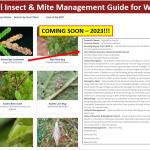
 An update on the progress of the Professional Insect & Mite Management Guide for Woody Plants: we are in the home stretch for creating and making the management guide available to you! We hope you enjoy viewing these screenshots of what you can expect from this searchable, online guide. While we are still working out the “bugs” in the various different search functions, the initial version of this guide will include searches by insect scientific name, insect common name, host plant, and (hopefully) growing degree days (GDD’s). However, the growing degree day search function may be a bit more complicated than the others, and as we know GDD ranges are not available for all insects. It is possible that the growing degree day search function may become available after the guide is released initially with the first three. As soon as this guide is available, Landscape Message readers will be among the first to know!
An update on the progress of the Professional Insect & Mite Management Guide for Woody Plants: we are in the home stretch for creating and making the management guide available to you! We hope you enjoy viewing these screenshots of what you can expect from this searchable, online guide. While we are still working out the “bugs” in the various different search functions, the initial version of this guide will include searches by insect scientific name, insect common name, host plant, and (hopefully) growing degree days (GDD’s). However, the growing degree day search function may be a bit more complicated than the others, and as we know GDD ranges are not available for all insects. It is possible that the growing degree day search function may become available after the guide is released initially with the first three. As soon as this guide is available, Landscape Message readers will be among the first to know!
To begin the season, while insect activity remains low and plants are still dormant, I want to take the time to provide a few updates regarding invasive, non-native insect pests of trees and shrubs. These updates will then be followed by a select few species that may be useful to include in your springtime scouting. But prior to that, a quick reminder about ticks, which are active any time temperatures are above freezing. Here’s to the very best in the 2023 growing season!
Insects and Other Arthropods
- Deer Tick/Blacklegged Tick: Ixodes scapularis adults have been active all winter, as they typically are from October through May, and “quest” or search for hosts at any point when daytime temperatures are above freezing. Engorged females survive the winter and will lay 1,500+ eggs in the forest leaf litter beginning around Memorial Day (late May). For images of all deer tick life stages, along with an outline of the diseases they carry, visit:https://web.uri.edu/tickencounter/species/blacklegged-tick/ .
Anyone working in the yard and garden should be aware that there is the potential to encounter deer ticks. The deer tick or blacklegged tick can transmit Lyme disease, human babesiosis, human anaplasmosis, and other diseases. Preventative activities, such as daily tick checks, wearing appropriate clothing, and permethrin treatments for clothing (according to label instructions) can aid in reducing the risk that a tick will become attached to your body. If a tick cannot attach and feed, it will not transmit disease. For more information about personal protective measures, visit:https://web.uri.edu/tickencounter/prevention/protect-yourself/ .
The Center for Agriculture, Food, and the Environment provides a list of potential tick identification and testing resources here: https://ag.umass.edu/resources/tick-testing-resources .
*In the news: UMass Amherst has now been designated as the location for the New England Center of Excellence in Vector-Borne Diseases (NEWVEC). This CDC (Centers for Disease Control and Prevention) funded center will work to reduce the risk of vector-borne diseases spread by ticks, mosquitoes, and other blood-sucking insects or insect relatives in New England:https://www.umass.edu/news/article/cdc-designates-new-england-center-excellence-vector-borne-diseases-umass-amherst . For more information and to contact NEWVEC, visit:https://www.newvec.org/ . To contact the center for more information about their Spring 2023 Project ITCH (“Is Tick Control Helping”), visit:https://www.newvec.org/itch .
Woody ornamental insect and non-insect arthropod pests to consider, a selected few:
Highlighted Invasive Insects & Other Organisms Update:
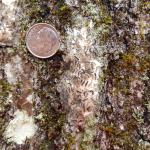 Spongy Moth: Lymantria dispar egg masses will be seen overwintering on just about any flat surface, including host plants such as oak, but also fencing, buildings, steps, outdoor furniture, and more. The end of winter and start of spring is a good time to scout properties, particularly in areas of Berkshire County, MA and abutting locations in CT and NY that experienced elevated L. dispar populations in 2022. If large numbers of egg masses are seen, plan to monitor them between 90-100 growing degree days (roughly the first week in May, but this varies) to better time egg hatch and caterpillar emergence. The MA Department of Conservation and Recreation, Forest Health Program reports that winter counts of spongy moth egg masses are higher than hoped for in parts of Berkshire County coming into the spring of 2023. This may mean that spongy moth caterpillars will again be noticeable in these areas this year, despite seeing caterpillar die-off from the spongy moth killing fungus Entomophaga maimaiga last season. For more information from the Forest Health Program, visit:https://storymaps.arcgis.com/stories/b60f63199fa14805a8b9f7c82447a25b and look under the spongy moth navigation tab.
Spongy Moth: Lymantria dispar egg masses will be seen overwintering on just about any flat surface, including host plants such as oak, but also fencing, buildings, steps, outdoor furniture, and more. The end of winter and start of spring is a good time to scout properties, particularly in areas of Berkshire County, MA and abutting locations in CT and NY that experienced elevated L. dispar populations in 2022. If large numbers of egg masses are seen, plan to monitor them between 90-100 growing degree days (roughly the first week in May, but this varies) to better time egg hatch and caterpillar emergence. The MA Department of Conservation and Recreation, Forest Health Program reports that winter counts of spongy moth egg masses are higher than hoped for in parts of Berkshire County coming into the spring of 2023. This may mean that spongy moth caterpillars will again be noticeable in these areas this year, despite seeing caterpillar die-off from the spongy moth killing fungus Entomophaga maimaiga last season. For more information from the Forest Health Program, visit:https://storymaps.arcgis.com/stories/b60f63199fa14805a8b9f7c82447a25b and look under the spongy moth navigation tab.
If egg masses are plentiful near high-value specimen trees in Berkshire County in 2023, consider applying the reduced risk insecticide Bacillus thuringiensis Kurstaki (Btk) to host plant leaves before caterpillars are over ¾ inch in length. Work with a licensed pesticide applicator and arborist to plan these applications, if necessary, especially if a high-value host plant was defoliated by this insect in 2021 or 2022.
The good news – homeowners in central and eastern Massachusetts will hopefully not have to worry too much about spongy moth this year. It may be undetectable in many central and eastern MA locations. MA DCR reports not seeing significant overwintering spongy moth egg masses in those locations. The primary area of concern includes parts of southwestern Berkshire County.
For more information about spongy moth, view the first episode of InsectXaminer, here:https://ag.umass.edu/landscape/education-events/insectxaminer .
Why did the common name for Lymantria dispar change recently? More information is available here:https://entsoc.org/news/press-releases/spongy-moth-approved-new-common-name-lymantria-dispar .
 Hemlock Woolly Adelgid: Adelges tsugae is present on eastern and Carolina hemlock. The overwintering hemlock woolly adelgid generation (sistens) is present through mid-spring and produces the spring generation (progrediens) which will be present from early spring through mid-summer. HWA, unlike many other insects, does most of its feeding over the winter. Hemlock woolly adelgid winter mortality (due to two significant regional cold snap events) is expected to be high for 2023. HWA that were most likely to survive these extreme cold events are those on lower host tree branches, if they were insulated by snow pack at the time. Determine if HWA are alive or dead on host plants before making chemical management decisions. This can be done quickly in the field by squishing overwintered HWA in their ovisacs between your thumb and forefinger and looking for a dark brown/blackish stain (from the hemolymph, or insect blood). If staining does not occur, the insect may have died and dried up. Test at least a few insects on at least a few branches to determine if any are alive. (Much more extensive examination may involve viewing at least 200 adelgids per site/location to calculate percent winter mortality.)
Hemlock Woolly Adelgid: Adelges tsugae is present on eastern and Carolina hemlock. The overwintering hemlock woolly adelgid generation (sistens) is present through mid-spring and produces the spring generation (progrediens) which will be present from early spring through mid-summer. HWA, unlike many other insects, does most of its feeding over the winter. Hemlock woolly adelgid winter mortality (due to two significant regional cold snap events) is expected to be high for 2023. HWA that were most likely to survive these extreme cold events are those on lower host tree branches, if they were insulated by snow pack at the time. Determine if HWA are alive or dead on host plants before making chemical management decisions. This can be done quickly in the field by squishing overwintered HWA in their ovisacs between your thumb and forefinger and looking for a dark brown/blackish stain (from the hemolymph, or insect blood). If staining does not occur, the insect may have died and dried up. Test at least a few insects on at least a few branches to determine if any are alive. (Much more extensive examination may involve viewing at least 200 adelgids per site/location to calculate percent winter mortality.)
Eggs may be found in woolly masses at the base of hemlock needles beginning in mid-March. Each woolly mass is created by a female who may then lay 50-300 eggs. Eggs hatch and crawlers may be found from mid-March through mid-July. Infested trees may be treated with foliar sprays in late April to early May, using Japanese quince as a phenological indicator. Systemic* applications may be made in the spring and fall, or when soil conditions are favorable for translocation to foliage. Nitrogen fertilizer applications may make hemlock woolly adelgid infestations worse.
*Note: beginning July 1, 2022 systemic insecticides known as neonicotinoids (including imidacloprid) have become state restricted use for tree and shrub uses in Massachusetts. More information is available, here:https://www.mass.gov/service-details/pesticide-newsupdates
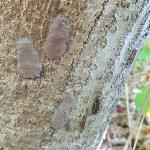 Spotted Lanternfly: (Lycorma delicatula, SLF) is a non-native, invasive insect that feeds on over 103 species of plants, including many trees and shrubs that are important in our landscapes. It overwinters as an egg mass, which the adult female insect lays on just about any flat surface. Pictures of egg masses can be seen here:https://massnrc.org/pests/linkeddocuments/SLFChecklistForResidents.pdf .
Spotted Lanternfly: (Lycorma delicatula, SLF) is a non-native, invasive insect that feeds on over 103 species of plants, including many trees and shrubs that are important in our landscapes. It overwinters as an egg mass, which the adult female insect lays on just about any flat surface. Pictures of egg masses can be seen here:https://massnrc.org/pests/linkeddocuments/SLFChecklistForResidents.pdf .
Currently, the only established populations of spotted lanternfly in Massachusetts are in Fitchburg, Shrewsbury, Worcester, and Springfield MA. Therefore, there is no reason to be preemptively treating for this insect in other areas of Massachusetts. If you suspect you have found spotted lanternfly in additional locations, please report it immediately to MDAR here:https://massnrc.org/pests/slfreport.aspx . If you are living and working in the Fitchburg, Shrewsbury, Worcester, and Springfield, MA areas, please be vigilant and continue to report anything suspicious.
For More Information:
From UMass Extension:
*New*: Spotted Lanternfly Management Guide for Professionals:https://ag.umass.edu/landscape/fact-sheets/spotted-lanternfly-management
*Note that management may only be necessary in areas where this insect has become established in Massachusetts, and if high value host plants are at risk. Preemptive management of the spotted lanternfly is not recommended.
Fact Sheet:https://ag.umass.edu/landscape/fact-sheets/spotted-lanternfly
Check out the InsectXaminer Episode about spotted lanternfly adults and egg masses! Available here:https://ag.umass.edu/landscape/education-events/insectxaminer
From the MA Department of Agricultural Resources:
Fact Sheet and Map of Locations in MA:https://massnrc.org/pests/pestFAQsheets/spottedlanternfly.html
Spotted Lanternfly Management Guide for Homeowners in Infested Areas:https://massnrc.org/pests/linkeddocuments/SLFHomeownerMgmtGuide.pdf
- Asian Longhorned Beetle: (Anoplophora glabripennis, ALB) Look for signs of an ALB infestation which include perfectly round exit holes (about the size of a dime), shallow oval or round scars in the bark where a female has chewed an egg site, or sawdust-like frass (excrement) on the ground nearby host trees or caught in between branches. Be advised that other, native insects may create perfectly round exit holes or sawdust-like frass, which can be confused with signs of ALB activity.
The regulated area for Asian longhorned beetle is 110 square miles encompassing Worcester, Shrewsbury, Boylston, West Boylston, and parts of Holden and Auburn. If you believe you have seen damage caused by this insect, such as exit holes or egg sites, on susceptible host trees like maple, please call the Asian Longhorned Beetle Eradication Program office in Worcester, MA at 508-852-8090 or toll free at 1-866-702-9938.
To report an Asian longhorned beetle find online or compare it to common insect look-alikes, visit:http://massnrc.org/pests/albreport.aspx orhttps://www.aphis.usda.gov/pests-diseases/alb/report .
 Emerald Ash Borer: (Agrilus planipennis, EAB) has been detected in at least 11 out of the 14 counties in Massachusetts.A map of these locations across the state may be found here:https://ag.umass.edu/fact-sheets/emerald-ash-borer . Additional information about this insect is provided by the MA Department of Conservation and Recreation, here:https://storymaps.arcgis.com/stories/b60f63199fa14805a8b9f7c82447a25b .
Emerald Ash Borer: (Agrilus planipennis, EAB) has been detected in at least 11 out of the 14 counties in Massachusetts.A map of these locations across the state may be found here:https://ag.umass.edu/fact-sheets/emerald-ash-borer . Additional information about this insect is provided by the MA Department of Conservation and Recreation, here:https://storymaps.arcgis.com/stories/b60f63199fa14805a8b9f7c82447a25b .
This wood-boring beetle readily attacks ash (Fraxinus spp.) including white, green, and black ash and has also been found developing in white fringe tree (Chionanthus virginicus) and has been reported in cultivated olive (Olea europaea). Signs of an EAB infested tree may include D-shaped exit holes in the bark (from adult emergence), “blonding” or lighter coloration of the ash bark from woodpecker feeding (chipping away of the bark as they search for larvae beneath), and serpentine galleries visible through splits in the bark, from larval feeding beneath. It is interesting to note that woodpeckers are capable of eating 30-95% of the emerald ash borer larvae found in a single tree (Murphy et al. 2018). Unfortunately, despite high predation rates, EAB populations continue to grow. However, there is hope that biological control efforts will eventually catch up with the emerald ash borer population and preserve some of our native ash tree species for the future.
- Winter Moth: (Operophtera brumata) data since 2017 has indicated that the winter moth population in eastern Massachusetts has been on the decline while the percent of winter moth pupae parasitized by Cyzenis albicans has increased! Dr. Joseph Elkinton’s laboratory at UMass Amherst has released this biological control agent of winter moth since 2005 and conducted the rigorous sampling required to determine where the insect has established and what its impact on the winter moth population has been at multiple sites in eastern MA.
The take-home point? Do not worry about winter moth this spring! In fact, management of this insect in landscaped settings will likely not be necessary in most locations. Blueberry growers may still, on the other hand, be interested in scouting and continuing to monitor for this insect, as only very low numbers of winter moth caterpillars might be tolerated in that system. In recent years, it is worth-while to note that some areas on the Cape and other locations in eastern MA have reported noticeable native cankerworm populations in the spring, which are often confused for winter moth. Read more about cankerworms in the spring scouting list below.
- Jumping Worms: Amynthas spp. earthworms, collectively referred to as “jumping or crazy or snake” worms, overwinter as eggs in tiny, mustard-seed sized cocoons found in the soil or other substrate (ex. compost). The tiny, impossible to remove cocoons will overwinter and provide a population of these earthworms in the 2023 season.
For More Information:
UMass Extension Fact Sheets:
- Earthworms in Massachusetts – History, Concerns, and Benefits: https://ag.umass.edu/landscape/fact-sheets/earthworms-in-massachusetts-history-concerns-benefits
- Jumping/Crazy/Snake Worms – Amynthas spp.: https://ag.umass.edu/landscape/fact-sheets/jumpingcrazysnake-worms-amynthas-spp
- A Summary of the Information Shared at UMass Extension’s Jumping Worm Conference in January 2022: https://ag.umass.edu/news-events/highlights/jumping-worms-conference
- Invasive Jumping Worm Frequently Asked Questions (Over 70 Questions and their Answers): https://ag.umass.edu/landscape/fact-sheets/invasive-jumping-worm-frequently-asked-questions
Spring Scouting Suggestions & Preparation for Upcoming Tree & Shrub Insects (Native and Invasive):
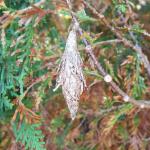 Bagworm:Thyridopteryx ephemeraeformis is a native species of moth whose larvae construct bag-like coverings over themselves with host plant leaves and twigs. This insect overwinters in the egg stage, within the bags of deceased females from last season. Eggs may hatch and young larvae are observed feeding around mid-June, or roughly between 600-900 GDD’s. Now is the time to scout for and remove and destroy overwintering bags. More information can be found here:https://ag.umass.edu/landscape/fact-sheets/bagworm
Bagworm:Thyridopteryx ephemeraeformis is a native species of moth whose larvae construct bag-like coverings over themselves with host plant leaves and twigs. This insect overwinters in the egg stage, within the bags of deceased females from last season. Eggs may hatch and young larvae are observed feeding around mid-June, or roughly between 600-900 GDD’s. Now is the time to scout for and remove and destroy overwintering bags. More information can be found here:https://ag.umass.edu/landscape/fact-sheets/bagworm- Balsam Twig Aphid:Mindarus abietinus overwinters as a silvery colored egg on host plant twigs. Eggs hatch just prior to budbreak and nymphs feed for a period of time on the undersides of last season’s needles before molting into a wingless stem mother. Stem mothers move to buds just as they open and give “live birth” to second generation nymphs. These second generation nymphs are the most damaging, feeding on new needles as they elongate, causing distortion and stunting. Excessive amounts of honeydew may be produced and cause needles to stick together. Foliar applications, if needed, may be made between 30-100 GDD’s, base 50°F on warm days before budcaps loosen. Inspect the twigs, near the base of needles of Balsam fir, Fraser fir, and other true firs for overwintering eggs and eventually the needles for feeding nymphs. This insect may be most problematic in Christmas tree production. In landscapes, many natural enemies can provide adequate management of this insect.
- Boxwood Leafminer: Monarthropalpus flavus partly grown fly larvae overwinter in the leaves of susceptible boxwood. Yellowish mines may be noticeable on the undersides of leaves. This insect grows rapidly in the spring, transforming into an orange-colored pupa. After pupation, adults will emerge and white colored pupal cases may hang down from the underside of leaves where adults have emerged. Adults may be observed swarming hosts between 300-650 GDD’s, or roughly the end of May through June. Most cultivars of Buxus sempervirens and B. microphylla are thought to be susceptible. If installing new boxwoods this spring, resistant cultivars such as ‘Vardar Valley’ and ‘Handsworthiensis’ are good choices at sites where this insect has been a problem.
- Boxwood Mite: Eurytetranychus buxi overwinter as tiny eggs on boxwood leaves and hatch mid-spring. These mites are tiny (about the size of a period) and difficult to detect. Feeding may cause plants to appear off-color. If management is deemed necessary, the timing for treatment may be between 245-600 GDD’s or roughly the beginning of May.
- Boxwood Psyllid:Psylla buxi feeding can cause cupping of susceptible boxwood leaves. Leaf symptoms/damage may remain on plants for up to two years. English boxwood may be less severely impacted by this pest. Eggs overwinter, buried in budscales, and hatch around budbreak of boxwood. Eggs may hatch around 80 GDD’s. While foliar applications may be made between 290-440 GDD’s, the damage caused by this insect is mostly aesthetic. Therefore, typically, management is not necessary.
- Cankerworms: Alsophila pometaria (fall cankerworm) and Paleacrita vernata (spring cankerworm) are often confused for winter moth (Operophtera brumata). Cankerworm populations in eastern MA, particularly on areas of Cape Cod, were confused for winter moth in 2019. Spring cankerworm adults are active in February and March, and fall cankerworm adults are active in late November into early December. During these times, both species lay eggs. These native insects most commonly utilize elm, apple, oak, linden, and beech. Eggs of both species hatch as soon as buds begin to open in the spring. Caterpillars occur in mixed populations and are often noticeable by mid-May in MA. Young larvae will feed on buds and unfolding leaves. There are two color forms (light green and dark) for caterpillars of both species. Like winter moth, they will drop to the soil to pupate. This usually occurs in June. Fall cankerworm larvae have three pairs of prolegs (one of which is small so it is sometimes referred to as ½) and spring cankerworm have two pairs. (Winter moth caterpillars also have 2 pairs of prolegs.) If populations are large and damage is noticeable on hosts, reduced risk insecticides such as Bacillus thuringiensis Kurstaki or spinosad may target larvae between approximately 148-290 GDD’s.
- Cooley Spruce Gall Adelgid: Adelges cooleyi is a native insect that has a complex life cycle. It has at least five different morphological forms, and requires 2 years and two hosts to complete its normal life cycle. Galls (pineapple shaped/cone-like and at the tips of twigs) are produced on Colorado blue spruce, Engelmann, Sitka, and Oriental spruce and cause needle injury (yellow spots and distortion) to Douglas-fir. Immature females overwinter on spruce near twig terminals. In the early spring, females mature into stem mothers and lay hundreds of eggs on lateral terminals. Upon egg hatch, nymphs migrate to new spring growth and feed at the base of growing needles. Immatures can be targeted on spruce between 22-81 GDD’s (mid-late April). On Douglas-fir, dormant oil applications should be made immediately before budbreak to avoid phytotoxicity. Follow all label instructions.
- Eastern Spruce Gall Adelgid:Adelges abietis is a pest of Norway spruce primarily, but occasionally damages other spruce species such as Colorado blue, white, and red spruce. This adelgid overwinters as a partially grown female, often referred to as a stem mother. This overwintering individual matures around bud break and lays 100-200 eggs. The eastern spruce gall adelgid may be targeted for management between 22-170 GDD’s, base 50°F (mid-April to early-May). This insect is non-native, and was introduced into the United States from Europe before 1900. Galls are small, sometimes pineapple shaped/variable, but produced on the basal portion of the shoots, such that the twig extends beyond the gall. Twig dieback may occur.
- Eastern Tent Caterpillar:Malacosoma americanum eggs overwinter on host plant twigs. Egg hatch typically occurs when wild cherry leaves begin to unfold and young caterpillars may emerge by late-April through the first two weeks in May (90-190 GDD’s). Susceptible hosts include cherry and crabapple. Other host plants whose leaves are fed upon by this native insect can include apple, ash, birch, willow, maple, oak, poplar, and witch-hazel. Prune off and remove egg masses from ornamental host plants by early spring. Eastern tent caterpillars are native to Massachusetts and have many associated natural enemies (parasites and predators) that help regulate populations. Unless these caterpillars are actively defoliating specimen trees in a landscaped setting, we can coexist with this particular herbivore native to our forests.
- Elongate Hemlock Scale:Fiorinia externa is found on eastern, Carolina, and Japanese hemlock, as well as yew, spruce, and fir. The elongate hemlock scale may overwinter in various life stages, and overlap of many developmental stages at any given time can be observed throughout much of the season. Dormant oil applications for this pest can occur according to label instructions in April, roughly between 7-120 GDD’s. Treatments for the crawler, or mobile, stage of this insect may be made in late May through mid-June, or between 360-700 GDD’s, base 50°F. Nitrogen fertilizer applications may make elongate hemlock scale infestations worse.
- Euonymus Scale: Unaspis euonymi is an armored scale that can be found on euonymus, holly, bittersweet, and pachysandra. This insect can cause yellow spotting on leaves, dieback, and distorted bark. Dormant oil applications can be made between 35-120 GDD’s or roughly from mid-April to early-May. For crawlers, early June timing is suggested between 533-820 GDD’s. (Eggs begin to hatch in early June.)
- European Pine Sawfly: Neodiprion sertiferoverwinters in the egg stage. Eggs are laid by females the previous season by cutting slits in needles using their ovipositors and depositing 6-8 eggs in each of 10-12 needles. Egg hatch occurs from late-April to mid-May and caterpillars become active roughly between 78-220 GDD, base 50°F. The primary host in MA is Mugo pine but it can be found on Scots, red, jack, and Japanese red pine. It is also found on white, Austrian, ponderosa, shortleaf, and pitch pine when planted near the aforementioned species. This dark colored caterpillar feeds in tight groups and small numbers can be pruned or plucked out of host plants and destroyed. Spinosad products can be used whenever the caterpillars are actively feeding, usually by mid-May and when caterpillars are still small. Bacillus thuringiensis kurstaki is not effective against sawflies.
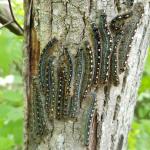 Forest Tent Caterpillar: Malacosoma disstria egg hatch occurs between 192-363 GDD’s, base 50°F, by mid-late May and caterpillars may be active for at least 5-6 weeks following. Susceptible hosts whose leaves are fed on by this insect include oak, birch, ash, maple, elm, poplar, and basswood. This native insect has many natural enemies, including some very effective pathogens that typically regulate populations. However, outbreaks of this insect can occur on occasion.
Forest Tent Caterpillar: Malacosoma disstria egg hatch occurs between 192-363 GDD’s, base 50°F, by mid-late May and caterpillars may be active for at least 5-6 weeks following. Susceptible hosts whose leaves are fed on by this insect include oak, birch, ash, maple, elm, poplar, and basswood. This native insect has many natural enemies, including some very effective pathogens that typically regulate populations. However, outbreaks of this insect can occur on occasion.- Hemlock Looper: Two species of geometrid moths in the genus Lambdina are native insects capable of defoliating eastern hemlock, balsam fir, and white spruce. Adult moths lay their eggs on the trunk and limbs of hosts in September and October, and eggs will hatch by late May or early June. (L. fiscellaria caterpillars may be active between 448-707 GDD’s.) Monitor susceptible hosts for small, inch-worm like caterpillars. Where populations are low, no management is necessary. Hemlock loopers have several effective natural enemies.
 Imported Willow Leaf Beetle:Plagiodera versicolora adult beetles overwinter near susceptible hosts. Adult beetles will chew holes and notches in the leaves of willow once they become available. Females lay yellow eggs in clusters on the undersides of leaves. Larvae are slug-like and bluish-green in color. They will feed in clusters and skeletonize the leaves. Most plants can tolerate the feeding from this insect, and foliage will appear brown. Repeated yearly feeding can be an issue, in which case management of the young larvae may be necessary. Take care with treatment in areas near water.
Imported Willow Leaf Beetle:Plagiodera versicolora adult beetles overwinter near susceptible hosts. Adult beetles will chew holes and notches in the leaves of willow once they become available. Females lay yellow eggs in clusters on the undersides of leaves. Larvae are slug-like and bluish-green in color. They will feed in clusters and skeletonize the leaves. Most plants can tolerate the feeding from this insect, and foliage will appear brown. Repeated yearly feeding can be an issue, in which case management of the young larvae may be necessary. Take care with treatment in areas near water.
Check out Episode 4 of InsectXaminer to see the imported willow leaf beetle in action:https://ag.umass.edu/landscape/education-events/insectxaminer
- Lecanium Scales (Oak): Parthenolecanium quercifexoverwinters as a second instar nymph on oak twigs. Females will begin feeding and mature in the spring, from mid-April to early May and eggs may be laid between late May and into June. Eggs hatch in June or early July and crawlers migrate to host plant leaves where they spend the summer and migrate as second instars back to host plant twigs in the fall. Mid-April to early-May (35-145 GDD’s) for dormant oil applications.
 Lily Leaf Beetle:Lilioceris liliiadults overwinter in sheltered places. As soon as susceptible hosts such as Lilium spp. (Turk’s cap, tiger, Easter, Asiatic, and Oriental lilies) and Fritillaria spp. break through the ground, the adult lily leaf beetles are known to feed on the new foliage. (Note: daylilies are not hosts.) Typically, in May, mating will occur and each female will begin to lay 250-450 eggs in neat rows on the underside of the foliage. If there are only a few plants in the garden, hand picking and destroying overwintering adults can help reduce local garden-level populations at that time.
Lily Leaf Beetle:Lilioceris liliiadults overwinter in sheltered places. As soon as susceptible hosts such as Lilium spp. (Turk’s cap, tiger, Easter, Asiatic, and Oriental lilies) and Fritillaria spp. break through the ground, the adult lily leaf beetles are known to feed on the new foliage. (Note: daylilies are not hosts.) Typically, in May, mating will occur and each female will begin to lay 250-450 eggs in neat rows on the underside of the foliage. If there are only a few plants in the garden, hand picking and destroying overwintering adults can help reduce local garden-level populations at that time.
Check out Episode 3 of InsectXaminer to see the lily leaf beetle in action:https://ag.umass.edu/landscape/education-events/insectxaminer
- Magnolia Scale: Neolecanium cornuparvum overwinters as first instar nymphs which are elliptical, and dark slate gray in color and can usually be found on the undersides of 1 and 2 year old twigs. Nymphs may molt by late April or May and again by early June at which time the scales may be purple in color. Eventually nymphs secrete a white powdery layer of wax over their bodies. Dormant oils can be applied between 7-35 GDD’s targeting the overwintering nymphs. Avoid applications to opening buds or blooms.
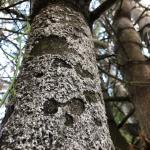 Pine Bark Adelgid: Pineus strobi overwinters as an immature which begins feeding during the first days of warm weather in the spring and begins secreting white wax over itself, which can eventually coat the entire trunk of infested trees. Egg laying may begin in April. This insect can be found on the trunk, branches, twigs, and the base of needles on new shoots. Spruce is a secondary host but this adelgid can repeatedly reproduce itself on pine. Wash off bark with a strong jet of water. If necessary, dormant oil applications can be made in mid-late April between 22-58 GDDs. Hosts include eastern white, Scots, and Austrian pines. This insect does little damage to healthy trees and can often be tolerated.
Pine Bark Adelgid: Pineus strobi overwinters as an immature which begins feeding during the first days of warm weather in the spring and begins secreting white wax over itself, which can eventually coat the entire trunk of infested trees. Egg laying may begin in April. This insect can be found on the trunk, branches, twigs, and the base of needles on new shoots. Spruce is a secondary host but this adelgid can repeatedly reproduce itself on pine. Wash off bark with a strong jet of water. If necessary, dormant oil applications can be made in mid-late April between 22-58 GDDs. Hosts include eastern white, Scots, and Austrian pines. This insect does little damage to healthy trees and can often be tolerated.- Snowball Aphid: Neoceruraphis viburnicolaeggs overwinter on viburnum twigs and buds. Eggs hatch and this aphid becomes active on certain species of viburnum roughly between 148-298 GDD’s or around redbud bloom. This insect is particularly noticeable on V. opulus, V. prunifolium, and V. acerifolia. Stem mothers, appearing blueish-white, can be found in curled up and distorted foliage. Damage caused by this insect pest is mostly aesthetic.
- Spruce Bud Scale: Physokermes piceae is a pest of Alberta and Norway spruce, among others. Immatures overwinter on the undersides of spruce needles, dormant until late March. By April, females may move to twigs to complete the rest of their development. Dormant oil applications may be made between 22-121 GDDs. Follow all label instructions, as oil may remove the bluish color from certain conifers. Mature scales are reddish brown, globular, 3 mm. in diameter, and found in clusters of 3-8 at the base of new twig growth. They closely resemble buds and are often overlooked. Crawlers are present around June.
- Spruce Spider Mite:Oligonychus ununguisis a cool-season mite that becomes active in the spring from tiny eggs that have overwintered on host plants. Hosts include spruce, arborvitae, juniper, hemlock, pine, Douglas-fir, and occasionally other conifers. This particular species becomes active in the spring and can feed, develop, and reproduce through roughly June. When hot, dry summer conditions begin, this spider mite will enter a summer-time dormant period (aestivation) until cooler temperatures return in the fall. This particular mite may prefer older needles to newer ones for food. When damaging spruce spider mite populations are known from last season, dormant oil applications can be made (when temperatures are appropriate according to label instructions) between 7-121 GDD’s, base 50°F (April). Magnification is required to view spruce spider mite eggs. Tapping host plant branches over white paper may be a useful tool when scouting for spider mite presence. (View with a hand lens.) Spider mite damage may appear on host plant needles as yellow stippling and occasionally fine silk webbing is visible.
- Viburnum Leaf Beetle:Pyrrhalta viburni is a beetle in the family Chrysomelidae that is native to Europe, but was found in Massachusetts in 2004. Viburnum leaf beetle overwinters as eggs laid in capped pits on the newest growth of susceptible viburnum branches. Scout for overwintered eggs and prune out and destroy before they hatch. Egg hatch occurs in late-April to early-May as temperatures warm and foliage becomes available. Monitor for larvae in mid-May (80-120 GDD’s). This beetle feeds exclusively on many different species of viburnum, which includes, but is not limited to, susceptible plants such as V. dentatum, V. nudum, V. opulus, V. propinquum, and V. rafinesquianum. Some viburnum have been observed to have varying levels of resistance to this insect, including but not limited to V. bodnantense, V. carlesii, V. davidii, V. plicatum, V. rhytidophyllum, V. setigerum, and V. sieboldii. More information about viburnum leaf beetle may be found athttp://www.hort.cornell.edu/vlb/ .
- White Pine Weevil: Pissodes strobi adults overwinter in sheltered locations in the leaf litter and become active very early in the spring, when daytime temperatures reach 50°F and before the bloom of forsythia (between 7-58 GDDs). Hosts include eastern white pine, Norway spruce, scotch, pitch, and red pine, blue spruce, and white spruce. Adults will begin feeding on bark 7-10 inches below dormant terminal buds. Females will deposit eggs in terminal growth bark, and developing larvae will feed in leaders until they mature in July when pupation occurs in pupal chambers made of wood chips. Management in nurseries or Christmas tree production may be necessary. Target adults between 7-58 GDD’s.
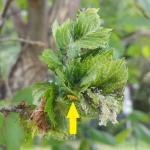 Woolly Apple Aphid:Eriosoma lanigerum may be found on apple, crabapple, hawthorn, mountain-ash, Pyracantha, and elm hosts. The primary (winter) host is elm, on which aphids infest emerging spring leaves, causing leaves to curl or close into stunted, rosette-like clusters found at twig tips. On apple and crabapple, this species of aphid colonizes roots, trunks, and branches in the summer and is commonly found near previous wounds or callous tissue. On roots, the aphids cause swelled areas which can girdle and kill roots. The aphids, when found in above ground plant parts such as elm leaves, are covered with white wax. Eggs are the overwintering stage on elm, which hatch in the spring in time for the nymphs to infest new elm foliage. Following a few generations on elm, the aphids will develop into a winged form, which will disperse and seek out apple and crabapple. Multiple generations will occur on these alternate hosts in the summer and by the fall, a winged form will return to elm and mated females will lay eggs near elm buds. These aphids are a favorite snack for insect predators such as the multicolored Asian lady beetle, Harmonia axyridis.
Woolly Apple Aphid:Eriosoma lanigerum may be found on apple, crabapple, hawthorn, mountain-ash, Pyracantha, and elm hosts. The primary (winter) host is elm, on which aphids infest emerging spring leaves, causing leaves to curl or close into stunted, rosette-like clusters found at twig tips. On apple and crabapple, this species of aphid colonizes roots, trunks, and branches in the summer and is commonly found near previous wounds or callous tissue. On roots, the aphids cause swelled areas which can girdle and kill roots. The aphids, when found in above ground plant parts such as elm leaves, are covered with white wax. Eggs are the overwintering stage on elm, which hatch in the spring in time for the nymphs to infest new elm foliage. Following a few generations on elm, the aphids will develop into a winged form, which will disperse and seek out apple and crabapple. Multiple generations will occur on these alternate hosts in the summer and by the fall, a winged form will return to elm and mated females will lay eggs near elm buds. These aphids are a favorite snack for insect predators such as the multicolored Asian lady beetle, Harmonia axyridis.
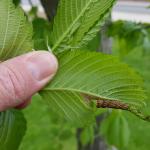 Woolly Elm Aphid: Eriosoma americanum females lay a single egg in the cracks and crevices of elm bark, where the egg overwinters. Eggs hatch on elm in the spring as leaves are unfolding. Aphids may be active from 121-246 GDD’s, base 50°F on elm. A young, wingless female hatched from the egg feeds on the underside of leaf tissue. This female aphid matures and gives birth to 200 young, all females, without mating. These aphids feed, and the elm leaf curls around them and protects them. By the end of June, winged migrants mature and find serviceberry hosts. Another set of females is produced. These new females crawl to and begin feeding on the roots of serviceberry. Multiple generations occur on the roots of serviceberry through the summer.
Woolly Elm Aphid: Eriosoma americanum females lay a single egg in the cracks and crevices of elm bark, where the egg overwinters. Eggs hatch on elm in the spring as leaves are unfolding. Aphids may be active from 121-246 GDD’s, base 50°F on elm. A young, wingless female hatched from the egg feeds on the underside of leaf tissue. This female aphid matures and gives birth to 200 young, all females, without mating. These aphids feed, and the elm leaf curls around them and protects them. By the end of June, winged migrants mature and find serviceberry hosts. Another set of females is produced. These new females crawl to and begin feeding on the roots of serviceberry. Multiple generations occur on the roots of serviceberry through the summer.
Concerned that you may have found an invasive insect or suspicious damage caused by one? Need to report a pest sighting? If so, please visit the Massachusetts Introduced Pests Outreach Project:http://massnrc.org/pests/pestreports.htm .
Reported by Tawny Simisky, Extension Entomologist, UMass Extension Landscape, Nursery, & Urban Forestry Program
Additional Resources
Pesticide License Exams - The MA Dept. of Agricultural Resources (MDAR) is now holding exams online. For more information and how to register, go to: https://www.mass.gov/pesticide-examination-and-licensing.
To receive immediate notification when the next Landscape Message update is posted, join our e-mail list or follow us on Facebook.
For a complete listing of upcoming events, see our upcoming educational events https://ag.umass.edu/landscape/upcoming-events
For commercial growers of greenhouse crops and flowers - Check out UMass Extension's Greenhouse Update website
For professional turf managers - Check out Turf Management Updates
For home gardeners and garden retailers - Check out our home lawn and garden resources.
Diagnostic Services
UMass Laboratory Diagnoses Landscape and Turf Problems - The UMass Extension Plant Diagnostic Lab is available to serve commercial landscape contractors, turf managers, arborists, nurseries and other green industry professionals. It provides woody plant and turf disease analysis, woody plant and turf insect identification, turfgrass identification, weed identification, and offers a report of pest management strategies that are research based, economically sound and environmentally appropriate for the situation. Accurate diagnosis for a turf or landscape problem can often eliminate or reduce the need for pesticide use. For sampling procedures, detailed submission instructions and a list of fees, see Plant Diagnostic Laboratory
Soil and Plant Nutrient Testing - The University of Massachusetts Soil and Plant Nutrient Testing Laboratory is located on the campus of The University of Massachusetts at Amherst. Testing services are available to all. The lab provides test results and recommendations that lead to the wise and economical use of soils and soil amendments. For more information, including current turn-around times, visit the UMass Soil and Plant Nutrient Testing Laboratory web site. The lab is currently accepting new orders for Routine Soil Analysis (including optional Organic Matter, Soluble Salts, and Nitrate testing), Particle Size Analysis, Pre-Sidedress Nitrate (PSNT), and Soilless Media (no other types of soil analyses available at this time). See https://ag.umass.edu/services/soil-plant-nutrient-testing-laboratory/ordering-information-forms/turnaround-time-for-routine-soil-analysis for current turnaround time. Please plan for the fact that date of receipt in the lab is affected by weekends, holidays, shipping time, and time for UMass Campus Mail to deliver samples to the lab.
Tick Testing - The UMass Center for Agriculture, Food, and the Environment provides a list of potential tick identification and testing options at: https://ag.umass.edu/resources/tick-testing-resources.
Acknowledgements: UMass Extension gratefully acknowledges the support of the following funding sources for the production of the Landscape Message –
- The Massachusetts Nursery and Landscape Association Fund
- The Massachusetts Department of Conservation and Recreation, Award #ISADCR28219926UMA22A
- Stakeholders like you! The Landscape Message is partially supported by educational program user fees.



